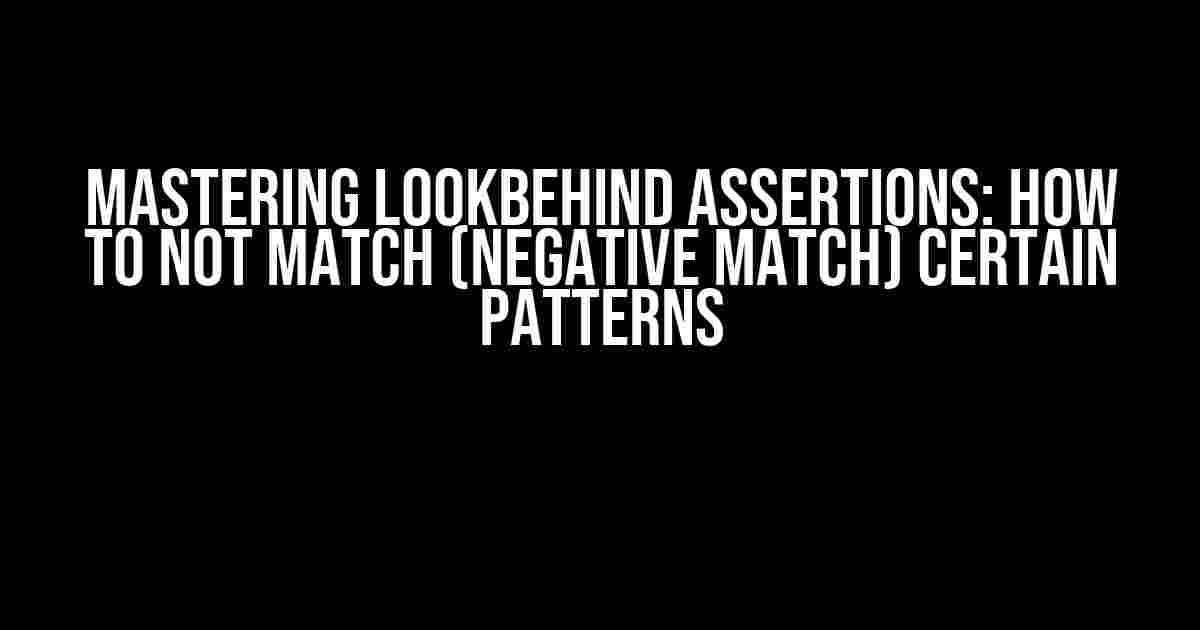Lookbehind assertions are a powerful tool in regular expressions, allowing you to match patterns based on what comes before them. But what if you want to do the opposite – to not match certain patterns? In this article, we’ll explore the art of negative matching in lookbehind assertions, and provide you with the skills to exclude unwanted matches.
What are Lookbehind Assertions?
Before we dive into negative matching, let’s quickly revisit what lookbehind assertions are. A lookbehind assertion is a type of zero-width assertion that checks if the current position in the string is preceded by a certain pattern. There are two types of lookbehind assertions:
(?<=pattern): Positive lookbehind – matches if the current position is preceded by the pattern.(?<!pattern): Negative lookbehind – matches if the current position is not preceded by the pattern.
Negative Lookbehind: The Basics
A negative lookbehind assertion is used to exclude matches that are preceded by a certain pattern. The syntax is simple:
(?<!pattern)
Here, pattern is the sequence of characters you want to exclude. For example, to match any character that is not preceded by the string “abc”, you would use:
(?<!abc).)
This will match any character (represented by the dot) that is not immediately preceded by the string “abc”.
Examples and Use Cases
Negative lookbehind assertions are useful in a variety of scenarios. Here are a few examples:
Excluding URLs with a Certain Domain
Suppose you want to match URLs that do not have the domain “example.com”. You can use a negative lookbehind assertion to exclude them:
(?<!https?://example\.com/).*
This will match any URL that does not have the domain “example.com”.
Ignoring Code Comments
In programming languages, comments are often denoted by specific characters or sequences. You can use a negative lookbehind assertion to ignore code comments:
(?<!(?:\/\/|\/\*).*?
This will match any character that is not preceded by a C-style comment (//) or a block comment (/* */).
Negative Lookbehind with Multiple Patterns
Sometimes, you need to exclude multiple patterns. You can do this by using the | character to separate the patterns:
(?<!(pattern1|pattern2|pattern3))
For example, to exclude URLs with either the domain “example.com” or “example.net”, you would use:
(?<!(https?://example\.com/|https?://example\.net/)).*
This will match any URL that does not have either of the two domains.
Negative Lookbehind with Character Classes
Character classes are a convenient way to match multiple characters at once. You can use character classes in negative lookbehind assertions to exclude a range of characters:
(?<![aeiou])
This will match any character that is not a vowel (a, e, i, o, or u).
When working with negative lookbehind assertions, keep the following in mind:
Performance
Negative lookbehind assertions can be computationally expensive, especially when working with large strings. Be mindful of performance when using them extensively.
Variable-Length Patterns
Negative lookbehind assertions can be tricky when dealing with variable-length patterns. Make sure to test your patterns thoroughly to avoid unexpected matches.
Matching at the Start of the String
Remember that negative lookbehind assertions will not match at the start of the string. If you need to match at the start, consider using a positive lookbehind assertion instead.
Conclusion
Mastering negative lookbehind assertions is a crucial skill in regular expressions. By understanding how to exclude certain patterns, you can write more efficient and effective regex patterns. Remember to use them judiciously, and always test your patterns to ensure they’re working as intended.
| Pattern | Description |
|---|---|
| (?<!pattern) | Negative lookbehind – matches if the current position is not preceded by the pattern. |
| (?<!(pattern1|pattern2|pattern3)) | Negative lookbehind with multiple patterns – matches if the current position is not preceded by any of the patterns. |
| (?<![aeiou]) | Negative lookbehind with character classes – matches if the current position is not preceded by any of the characters in the class. |
With this comprehensive guide, you’re now equipped to tackle even the most complex negative matching scenarios. Happy regexing!
Frequently Asked Question
Get ready to master the art of negative matching in lookbehind!
How do I exclude a specific pattern from being matched in a lookbehind?
To exclude a specific pattern from being matched in a lookbehind, you can use a negative lookahead inside the lookbehind. For example, `(?(?
Can I use multiple negative lookaheads in a lookbehind?
Yes, you can! You can chain multiple negative lookaheads in a lookbehind to exclude multiple patterns. For example, `(?(?
How do I match a pattern that’s not preceded by a specific string?
Easy peasy! To match a pattern that’s not preceded by a specific string, you can use a negative lookbehind with a fixed-width pattern. For example, `(?!string_to_exclude)pattern_to_match` will match `pattern_to_match` only if it’s not immediately preceded by `string_to_exclude`. Note that this only works if the preceding string has a fixed width.
Can I use a negative lookahead instead of a negative lookbehind?
While it’s technically possible to use a negative lookahead instead of a negative lookbehind, it’s not always the best approach. Negative lookaheads can be less efficient and may cause performance issues, especially with complex patterns. Stick to negative lookbehinds whenever possible for a more elegant and efficient solution!
What are some common pitfalls to avoid when using negative matching in lookbehind?
Be careful not to overcomplicate your regex! Avoid using excessive nesting, ambiguous patterns, or overly broad negative lookbehinds that might cause performance issues or unexpected matches. Also, keep in mind that some regex flavors may have limitations or quirks when it comes to negative lookbehinds, so be sure to test your regex thoroughly!

